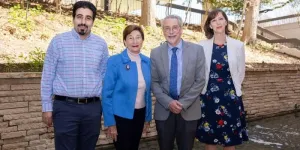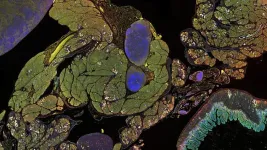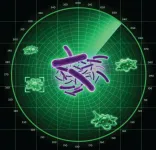(Press-News.org) World leaders should look to existing international law on the use of force to address the threat of space becoming ever more militarized, a new study shows.
Space has the potential to be a source and place of armed conflict and regulating military activities in space is of pressing international concern.
Tests of anti-satellite (ASAT) weapons have fuelled fears of warfare in space. Resulting space debris from ASAT weapon threatens other satellites in orbit, many of which underpin the operation of human societies and the functioning of global economies.
Conflict in space could have catastrophic effects on civilians and state interests, both on Earth and in space.
Despite the importance of satellites and the need to protect space from the effects of military activities, multilateral attempts to restrain the escalating weaponization of space have failed.
A new study argues existing laws, grounded in the UN Charter and customary international law, can help to secure international peace and security beyond the Earth’s atmosphere.
The study, by Chris O’Meara from the University of Exeter Law School, argues that existing law can be used to limit when and how states may lawfully target satellites using ASAT technologies, even in self-defence.
A clearer understanding of these rules allows states to protect their vital space assets while also addressing state concerns regarding space debris, civilian harm, and avoiding conflict in space. Adherence to these legal requirements ultimately helps to secure international peace and security on Earth and in space.
Dr O’Meara said: “The prospect of war in space is of real concern and states assert their right to act to defend their interests in that domain. Unease over the militarization or ‘weaponization’ of space is accordingly at the top of the international agenda. Although states continue to develop new counterspace weapons, adherence to established legal requirements that can be interpreted and adapted to apply in outer space has the potential to limit ASAT weapon use.”
“A clearer understanding of these requirements directly addresses pressing international concerns regarding the weaponization of space and the fear of wars between states in that domain. As we all rely on satellite-based services in our daily lives, greater clarity regarding legal restraints on warfare in space benefits us all.”
END
Existing international law can help secure peace and security in outer space, study shows
2025-04-02
ELSE PRESS RELEASES FROM THIS DATE:
Pinning down the process of West Nile virus transmission
2025-04-02
COLUMBUS, Ohio – Mosquitoes have been transmitting the West Nile virus to humans in the United States for over 25 years, but we still don’t know precisely how the virus cycles through these pests and the other animals they bite.
A federally funded project aims to help pin down the process by using mathematical models to analyze how factors like temperature, light pollution, and bird and mosquito abundance affect West Nile virus transmission. The ultimate goal is to advise health departments of the best time of year to kill the bugs.
“I’m hopeful that what we will uncover in this grant will help us to better understand what’s driving West Nile virus transmission, ...
UTA-backed research tackles health challenges across ages
2025-04-02
Genevieve Graaf spent years as a mental health social worker specializing in children and youth with complex behavioral health needs. Many had to travel to other states or hundreds of miles from family to access adequate medical care. Drawing on her experience, Dr. Graaf, an assistant professor of social work at The University of Texas at Arlington, has continuously sought ways to improve community-based support programs and ease the burden on families.
She will build on that work with her latest research through UT Arlington’s Center ...
In pancreatic cancer, a race against time
2025-04-02
Pancreatic cancer is projected to become the second-deadliest cancer by 2030. By the time it’s diagnosed, it’s often difficult to treat. So, for both individual patients and the general population, fighting pancreatic cancer can feel like a race against time. Cold Spring Harbor Laboratory (CSHL) Professor and Cancer Center Director David Tuveson offers a telling analogy:
“We all have moles on our skin. Most of your moles are fine. But some of your moles you have a dermatologist looking at to make sure it’s always fine. They ...
Targeting FGFR2 may prevent or delay some KRAS-mutated pancreatic cancers
2025-04-02
Bottom Line: Precancerous pancreatic lesions and some pancreatic ductal adenocarcinoma (PDAC) tumors harboring KRAS mutations had higher-than-normal expression of the FGFR2 protein, and FGFR2 inactivation delayed KRAS-mutated PDAC development in mice.
Journal in Which the Study was Published: Cancer Research, a journal of the American Association for Cancer Research
Author: Claudia Tonelli, PhD, a research investigator in the laboratory of AACR Past President David A. Tuveson, MD, PhD, FAACR, at Cold Spring Harbor Laboratory
Background: PDAC is the most common ...
Melodies of musical ‘starquakes’ shed new light on how our galaxy formed
2025-04-02
They say music is the universal language of humankind, but some stars in our galaxy exhibit their own rhythm, offering fresh clues into how they and our galaxy evolved over time.
According to an international team of researchers, including scientists from The Australian National University (ANU) and UNSW Sydney, some stars exhibit fluctuations in their brightness over time, which are caused by continuous ‘starquakes’.
These fluctuations can be translated into frequencies, which can be used to determine a star’s age and other properties ...
Protective radar for bacteria
2025-04-02
Investigation how microorganisms communicate enhances our understanding of the complex ecological interactions that shape our environment – a major focus of the Cluster of Excellence “Balance of the Microverse”. A research team of the Cluster at the Leibniz Institute for Natural Product Research and Infection Biology - Hans Knöll Institute (Leibniz-HKI) and the Friedrich Schiller University, Jena has studied the interaction between amoebae, bacteria, and plants. Researchers from the ...
Increased utilization of overtime and agency nurses and patient safety
2025-04-02
About The Study: The findings of this study suggest that both nurse overtime and nurse agency hours are associated with increased rates of pressure ulcers, a measure that is one of the most sensitive to nursing care. In future research, hospitals could use their own data to track safe thresholds.
Corresponding Author: To contact the corresponding author, Patricia Pittman, PhD, email ppittman@gwu.edu.
To access the embargoed study: Visit our For The Media website at this link https://media.jamanetwork.com/
(doi:10.1001/jamanetworkopen.2025.2875)
Editor’s ...
Spending on glucagon-like peptide-1 receptor agonists among US adults
2025-04-02
About The Study: Spending on glucagon-like peptide-1 receptor agonists (GLP-1 RAs) increased from 2018 to 2023, with the largest growth rates from 2022 to 2023. Although spending for certain GLP-1 RAs increased substantially, spending declined for others. This study estimated that more than $71 billion was spent on GLP-1 RAs and more than $50 billion on a product based on either semaglutide or tirzepatide molecules.
Corresponding Author: To contact the corresponding author, Stavros Tsipas, MA, email stavros.tsipas@ama-assn.org.
To ...
Early-life ozone exposure and asthma and wheeze in children
2025-04-02
About The Study: In this cohort study with relatively low ambient ozone exposure, early-life ozone was associated with asthma and wheeze outcomes at age 4 to 6 and in mixture with other air pollutants but not at age 8 to 9. Regulating and reducing exposure to ambient ozone may help reduce the significant public health burden of asthma among U.S. children.
Corresponding Author: To contact the corresponding author, Logan C. Dearborn, MPH, email dearbl@uw.edu.
To access the embargoed study: Visit our For The Media website at this link https://media.jamanetwork.com/
(doi:10.1001/jamanetworkopen.2025.4121)
Editor’s ...
Early Earth's first crust composition discovery rewrites geological timeline
2025-04-02
Researchers have made a new discovery that changes our understanding of Earth’s early geological history, challenging beliefs about how our continents formed and when plate tectonics began.
A study published in Nature on 2 April reveals that Earth's first crust, formed about 4.5 billion years ago, probably had chemical features remarkably like today’s continental crust.
This suggests the distinctive chemical signature of our continents was established at the very beginning of Earth’s history.
Professor Emeritus Simon ...




